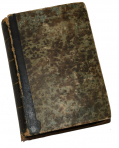site search
online catalog
IDENTIFIED CAVALRY TACTICS VOLUME OF WILLIAM PENN LLOYD VOL. 2 OF CAVALRY TACTICS GIVEN TO HIS ADJUTANT

$135.00 SOLD
Quantity Available: None
Item Code: 2024-1840
This is a nicely inscribed copy of Volume 2 of the cavalry tactics twice inscribed by William Bayard, on the title page and the flyleaf indicating it was Bayard’s own copy with the latter inscription later supplemented by the officer to whom Bayard had given it: “Presented by William Bayard To Wm. Penn Lloyd and studied by him when he served at Genl. George D. Bayard’s Head Quarters from May 5 1862 until the General was killed at Fredericksburg December 13” 1862 This study prepared him for his subsequent service as Adjutant of a Regiment and assistant adjt. Genl. of a Brigade.”
William Penn Loyd, 1837-1911, was a teacher, lawyer and politician, member of the G.A.R., and the Gettysburg Battlefield Commission, and also author of the history of the 1st Pa Cavalry. He enlisted/mustered in in that regiment 9/1/1861 as a private in Co. G and was promoted Hospital Steward as of 12/18/62. He made 1st Lieutenant 3/22/63, was assigned to Co. E, and Adjutant 9/1/63, assigned to the Field and Staff, mustering out 9/9/64.
Also known as the 44th Regiment of the PA line and the 15th PA Reserves, the regiment was first commanded by George D. Bayard as Colonel. General Bayard graduated West Point in 1856 and served in the 1st US Cavalry. As Colonel of the 1st PA Cavalry he served in the Shenandoah against Jackson and was promoted Brigadier General of Volunteers, and given command first of the cavalry of the 3rd Army Corps and then of cavalry of the “Left Grand Division.” He was mortally wounded at Fredericksburg by a shell burst while conferring with Gen. W.B. Franklin.
William Bayard was a distant cousin of George D. Bayard who managed to make his way back north from Texas when the war started and was purportedly promised a commission in the regular army early on by way of his connections with Robert Anderson (of Sumter fame.) In the meantime he joined his cousin’s regiment, gaining a commission as 2nd Lieutenant in the 1st PA Cavalry from 3/1/62 to 9/1/62 during which time he apparently served as regimental adjutant, and then as an aide on Bayard’s staff after his promotion to Brigadier General of Volunteers on 4/28/62, earning some praise for his behavior in the field. In the wake of Gen. Bayard’s death, Lincoln wrote to Stanton recommending him for a commission in the regular army, stating that he had acted as aide to Bayard all the way up to his death (likely as a volunteer aide de camp) which took a while longer to come through, and Bayard simply entered the 4th US Cavalry as an enlisted man, serving as private and corporal from 2/2/63 to October/November 1863 when his commission as 2nd Lieutenant finally came through as of 10/1/63. He served for the rest of the war in the western theatre, was posted to the 9th US Cavalry in 1866, and mustered out in January 1871, having received brevets to 1st Lieutenant, Captain, for gallant and meritorious service and to Major for gallantry during the pursuit of Hood after the Battle of Nashville “and in the charge of his regiment against the earthworks at Selma, Ala.”
This is in good condition, with wear to the binding as shown and minor foxing, nothing unexpected or unacceptable in a manual actually carried in the field and with some interesting historical associations to officers with a great deal of active service. [sr] [ph:L]
~~~~~~~~~~~~~~~~~~~~~~~~~~~~~~~~~~~
THIS ITEM, AS WITH ALL OTHER ITEMS AVAILABLE ON OUR WEB SITE,
MAY BE PURCHASED THROUGH OUR LAYAWAY PROGRAM.
CLICK HERE FOR OUR POLICIES AND TERMS.
THANK YOU!
Inquire About IDENTIFIED CAVALRY TACTICS VOLUME OF WILLIAM PENN LLOYD VOL. 2 OF CAVALRY TACTICS GIVEN TO HIS ADJUTANT
For inquiries, please email us at [email protected]
Most Popular
Historical Firearms Stolen From The National Civil War Museum In Harrisburg, Pa »
Theft From Gravesite Of Gen. John Reynolds »
Selection Of Unframed Prints By Don Troiani »
Fine Condition Brass Infantry Bugle Insignia »
Wonderful Condition Original Confederate-Manufactured Kepi For A Drummer Boy Or Child »
featured item
VERY RARE CONFEDERATE “ROPE BORDER” BELT PLATE
Dug condition stamped brass oval “rope border” belt plate. Unlike their US counterparts, these were not lead filled. These are not commonly found and can most often be traced back to the contractor Magee and George of New Orleans. The firm of… (1202-260). Learn More »









